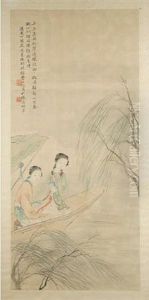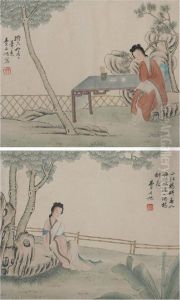Fei Danxu Paintings
Fei Danxu was a prominent Chinese artist known for his traditional Chinese painting during the Qing Dynasty. Born in 1801 in Fuchun, Zhejiang Province, Fei was part of a family with a rich artistic heritage. His grandfather, Fei Yigeng, and his father, Fei Yishi, were both well-regarded painters, which provided Fei Danxu with an environment conducive to developing his artistic skills from a young age.
Fei Danxu initially received training from his father and was heavily influenced by the 'Yangzhou School' of painting, which was known for its vibrant commercial art scene. He later moved to Yangzhou where he further developed his style. Fei's paintings are characterized by their vivid detail, bright colors, and dynamic compositions. He was particularly skilled in figure painting, but he also excelled in landscapes and bird-and-flower paintings.
Throughout his career, Fei Danxu enjoyed considerable success and was widely sought after for his work. He became known for his ability to blend traditional Chinese painting techniques with his own unique style, creating works that were both innovative and deeply rooted in Chinese artistic traditions. His paintings were not only appreciated for their aesthetic qualities but also for their poetic and sometimes playful nature, as he often incorporated calligraphy and poetry into his works.
Despite his success, there are records that suggest Fei Danxu struggled financially at times, possibly due to the changing tastes and economic conditions of the period. Nevertheless, he remains a significant figure in the history of Chinese art, and his works continue to be studied and admired for their beauty and technical mastery.
Fei Danxu's contributions to Chinese art were part of a larger trend during the Qing Dynasty, where individual expression and the commercialization of art played a significant role in the evolution of Chinese painting. His works have been preserved in various museums and private collections, ensuring that his legacy endures. Fei Danxu passed away in 1850, leaving behind a rich body of work that continues to influence the practice of traditional Chinese painting.





